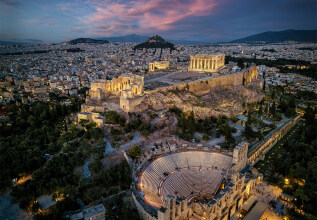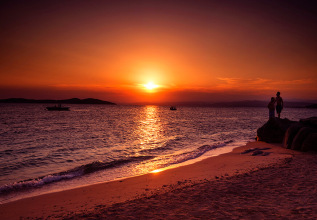3 MIN
TRAVEL TIPS
Nisyros: The Sleeping Giant of the Dodecanese

 Hydrothermal eruptions are not as catastrophic as magmatic ones, but they must have been as frightening, judging from the account of French geologist Henri Gorceix, who witnessed one in 1871: “After a violent quake the villagers of Nisyros heard crashes as loud as thunder; red and yellow flames leapt into the air, higher than the island’s loftiest peaks, falling back into the sea; the fields at the base of the original crater were covered in white dust. That same night, huge fumaroles opened up and since then have not ceased to vomit forth their fumes.”
The “legacy” of all those hydrothermal eruptions to future generations were the circular craters that are nowadays so popular with tourists. Of the 20 traced on the island, the largest, most imposing and most visited of all is the approximately 4,000-5,000-year-old Stefanos, known simply as “the volcano.” Elliptical in shape, with a diameter ranging from 260m to 330m and 27m deep, Stefanos is in fact one of the largest and best preserved hydrothermal craters in the world. Its fumaroles (the holes in the ground) are still puffing hydrogen sulfide and the water under the surface boils at corrosive temperatures. This serves as a reminder that even though Nisyros has not given any indication of magmatic activity for thousands of years, it is, nonetheless, a potentially active volcano. Therefore, a hydrothermal eruption following an earthquake is not out of the question. This is why there is a permanent observatory on the island to monitor earthquakes and volcanic activity.
see full article here
Hydrothermal eruptions are not as catastrophic as magmatic ones, but they must have been as frightening, judging from the account of French geologist Henri Gorceix, who witnessed one in 1871: “After a violent quake the villagers of Nisyros heard crashes as loud as thunder; red and yellow flames leapt into the air, higher than the island’s loftiest peaks, falling back into the sea; the fields at the base of the original crater were covered in white dust. That same night, huge fumaroles opened up and since then have not ceased to vomit forth their fumes.”
The “legacy” of all those hydrothermal eruptions to future generations were the circular craters that are nowadays so popular with tourists. Of the 20 traced on the island, the largest, most imposing and most visited of all is the approximately 4,000-5,000-year-old Stefanos, known simply as “the volcano.” Elliptical in shape, with a diameter ranging from 260m to 330m and 27m deep, Stefanos is in fact one of the largest and best preserved hydrothermal craters in the world. Its fumaroles (the holes in the ground) are still puffing hydrogen sulfide and the water under the surface boils at corrosive temperatures. This serves as a reminder that even though Nisyros has not given any indication of magmatic activity for thousands of years, it is, nonetheless, a potentially active volcano. Therefore, a hydrothermal eruption following an earthquake is not out of the question. This is why there is a permanent observatory on the island to monitor earthquakes and volcanic activity.
see full article here


